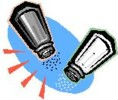Make the most of culinary herbs and spices.
I have long shied away from the medicinal side of herbs because so much of the information out there appeared to be gleaned more from folklore than fact. In days of yore the shape of a leaf, for instance, reflected how it might help the body. A heart-shaped leaf meant it would be good for heart ailments. American skullcap, so named because the flower resembles a skullcap, was said to alleviate headaches.
Now we have a true resource about the health benefits of herbs and spices in the book Healing Spices. Bharat B. Aggarwal, PhD, has compiled thousands of scientific studies into one easy to read volume. And it is fascinating.
Who would imagine that black cumin (Nigella sativa) has more than 100 compounds important to health? Or that sesame seed oil can dramatically reduce high blood pressure? Dr. Aggarwal can point to studies that prove these facts and has taken part in much of this revealing research.
Currently a professor of cancer research, biochemistry, immunology and experimental therapeutics at M.D. Anderson Cancer Center in Houston, Texas, Dr. Aggarwal has published more than 500 scientific papers and articles. Prior to M.D. Anderson, he worked for ten years as a molecular biologist and cancer researcher at Genentech Inc., a major biotechnology company.
Given these credentials, one might expect the author to deliver a somewhat technical (read boring) book, but this is so not the case. Instead, he writes in a conversational tone, breaking down complicated studies into understandable results while shedding new light on familiar spices.
Some of the spices are not so familiar. I have heard of ajowan and asafoetida but I don't have them in my spice cabinet, yet. Coconut and almonds were unexpected additions to the list of 50 herbs and spices, as were pomegranate and pumpkin seeds. Dr. Aggarwal makes a good argument for their inclusion. Spices by definition are seeds. (Herbs are leaves.)
He only includes a spice in the book "if there is intriguing or established science showing the spice may help prevent or heal specific conditions and diseases." Naturally, garlic is in there. I finally found the answer to a question I have been asked many times but could never answer. Dried or powdered garlic is just as therapeutic as fresh, and maybe even more so.
After reading many of the chapters I notice that the research is often done using the essential oils of an herb or spice. Although the book encourages us to get the health benefits by using the seasonings in the kitchen, I am left to wonder about the differences in concentration. Surely a teaspoon full of thyme leaves is less effective than the thymol (the volatile oil found in thyme) used in the laboratory.
One reason this book is so readable is the layout. Each chapter covers a single spice so you can pick it up and read about the ones that interest you the most. Within each chapter the doctor has divided the information into five categories: the healing potential; getting to know the spice; how to buy it; how to use it in the kitchen; and, a recipe showcasing the spice. Some chapters include drawings and sidebars with interesting tidbits. Other sidebars list maladies the herb or spice may help prevent or treat along with recommended pairings and recipes within the book that include that seasoning.
A handy table in the back lists health conditions, the spices to help and, occasionally, established recommended doses. Also in this back section are numerous recipes for spice blends, curries and hints for creating your own flavor combinations. I wish they had thought to include a recipe index.
The recipes that are included cover a wide range. Some are quite basic, like Cinnamon French Toast or Chicken Oreganata while others are complex. I couldn't resist trying out the recipe for Coconut Meatballs with Peanut Sauce. The result was excellent—moist, tender meatballs with a spicy, satisfying sauce.
The Madras Beef Curry from the coriander chapter was just okay. I whipped up a batch of Madras Curry Paste from the back of the book with ease and the recipe went together quickly as promised. The dish didn't have the vibrant flavor I expected. Even after refrigerating it for a couple of days to "develop a more intense flavor" as the recipe suggested, the curry was not very exciting.
This isn't a book you buy for the recipes, though. The information on the other pages is why you pick up Healing Spices. From writing this site's monthly newsletter, I thought I was fairly up to date on the advances in science on this topic. I had no idea so much research has been done and so many positive results have been proven. I'll bet you will be amazed too.
Find out more at Amazon.com:


